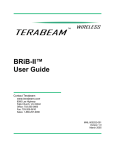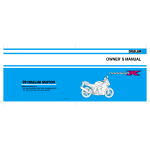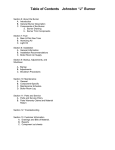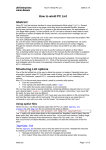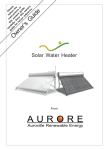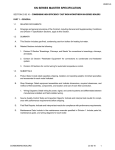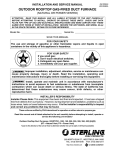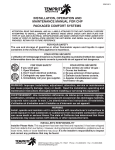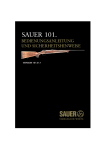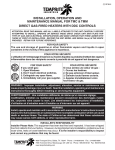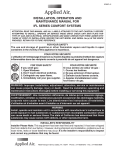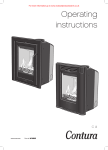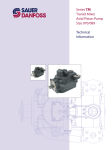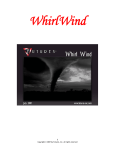Download EVAPORATIVE AND INDIRECT FIRED MAKE
Transcript
ALM-IOM-1 INSTALLATION, OPERATION AND MAINTENANCE MANUAL EVAPORATIVE AND INDIRECT FIRED MAKE-UP AIR UNITS ATTENTION: READ THIS MANUAL AND ALL LABELS ATTACHED TO THE UNIT CAREFULLY BEFORE ATTEMPTING TO INSTALL, OPERATE OR SERVICE THESE UNITS! CHECK UNIT DATA PLATE FOR TYPE OF GAS (WHERE APPLICABLE) AND ELECTRICAL SPECIFICATIONS AND MAKE CERTAIN THAT THESE AGREE WITH THOSE AT THE POINT OF INSTALLATION. RECORD THE UNIT MODEL AND SERIAL No.(s) IN THE SPACE PROVIDED. RETAIN FOR FUTURE REFERENCE. Alton Model No. Serial No. SAVE THIS MANUAL FOR YOUR SAFETY The use and storage of gasoline or other flammable vapors and liquids in open containers in the vicinity of this appliance is hazardous. FOR YOUR SAFETY If you smell gas: 1. Open windows. 2. Don't touch electrical switches. 3. Extinguish any open flame. 4. Immediately contact your gas supplier. WARNING: Improper installation, adjustment, alteration, service, or maintenance can cause property damage, injury, or death. Read the installation, operating, and maintenance instruction thoroughly before installing or servicing this equipment. WARNING Install, operate, and maintain unit in accordance with the manufacturer's instructions to avoid exposure to fuel substances, or substances from incomplete combustion, which can cause death or serious illness. The state of California has determined that these substances may cause cancer, birth defects, or other reproductive harm. INSTALLER'S RESPONSIBILITY Installer Please Note: This equipment has been tested and inspected. It has been shipped free from defects from our factory. However, shipment and installation problems such as loose wires, leaks, or loose fasteners may occur. It is the installer's responsibility to inspect and correct any problem that may be found. ATTENTION: READ CAREFULLY BEFORE ATTEMPTING TO INSTALL, OPERATE OR SERVICE THIS EQUIPMENT. RETAIN FOR FUTURE REFERENCE. POST AND MAINTAIN THESE INSTRUCTIONS IN LEGIBLE CONDITION. 4830 TRANSPORT DRIVE, DALLAS, TX 75247 PHONE: 214-638-6010 FAX: 214-905-0806 www.mestek.com SECTION I - FORWARD As is the case with any fine piece of equipment, care must be taken to provide attention to the operation and maintenance details of this machine. Table of Contents Section I: Forward and Table of Contents .................. 2 Section II: General Information ................................... 2 Section III: Installation ............................................. 3-5 Section IV: Pre-Start Up .......................................... 6-8 Section V: Unit Start Up ........................................ 8-10 Section VI: Unit Shut Down ....................................... 10 Section VII: Maintenance Schedule and Lubrication Requirements ......... 10-13 Section VII: Replacement Parts ................................ 13 Section IX: Troubleshooting Guide ..................... 14-17 This manual of instructions has been prepared in order for you to become well-acquainted with those details. In doing so, you will be able to give your Alton Evaporative Make-Up Air Unit the care and attention which any piece of equipment needs and deserves. SECTION II - GENERAL INFORMATION A. Purpose The purpose of this manual is to present a guide for proper installation, maintenance, and operation of the Evaporative Make-Up Air Unit, and supplement, but not to replace, the services of qualified field service personnel to supervise the initial start-up and adjustment of the unit. Persons without previous experience with large commercial and industrial HVAC equipment should not attempt the initial adjustment and checkout procedure which is essential before such installation may be considered ready for operation. This manual should be made readily available to all operation personnel as an aid in troubleshooting and proper maintenance. All equipment (and any optional accessories) should be checked carefully for physical damage in the presence of the carrier’s representative. Carefully examine the exterior and interior compartments of the equipment for transportation damage. If parts are missing or damage has occurred, a claim should be filed immediately with the carrier. Notify Alton of any shortage or items shipped in error. Prior written permission must be obtained from Alton before any merchandise may be returned. All Alton Evaporative Make-Up Air units are given a complete operations test and control circuit checkout before shipment. Copies of the wiring diagram, piping diagram, and bill of material are included with each unit shipped. If correspondence with the factory is necessary, please provide the unit model and serial number. B. Shipping Alton Evaporative Make-Up Air units are shipped completely assembled where shipping limitations allow. Optional inlet hoods, filter and/or damper sections, or other large accessories are assembled and shipped mounted and wired whenever possible within limitations of shipping and handling. Any optional accessories shipped separately are shipped as assembled sections. Any wired accessories which have been disassembled for separate shipment require no additional conduit or wire for field reassembly. All wire leads will be tagged for ease of reconnection in the field. C. Optional Factory Service Periodic service on any piece of mechanical equipment is necessary for efficient operation. Alton has a nationwide service support network available to provide quick and dependable servicing of all types of evaporative make-up air equipment. Alton also offers factory start-up service which includes the presence of a service engineer to supervise the initial start-up and adjustment of the equipment and provide instructions for the owner’s maintenance personnel in proper operations and maintenance. Consult factory for quotations on periodic or start-up service. Shipments are made F.O.B. Dallas, Texas by flatbed truck. The unit is securely strapped, tied, and blocked to prevent shipping damage. All shipments are checked by an inspector before they are accepted by the carrier. Parts that are shipped unmounted are noted on the bill of lading. These parts, where feasible, are packaged and shipped with the units. Upon receipt of shipment, all units should be checked against the bill of lading to insure all items have been received. Items shipped loose may be found packed in the evaporative cooling section, the mixing plenum section (if furnished) or the electrical control box (if furnished). 2 SECTION III - INSTALLATION FOR CANADIAN INSTALLATIONS ONLY 1. All installations must conform with local building codes, or, in the absence of local codes, with current CAN/CGA-B149-Installation Codes For Gas Burning Appliances and Equipment. Open the cover of the electrical control box (if furnished) located on the unit. Inspect all wire terminals and wiring terminations to ensure that all connections are tight. B. Locating the Unit Prior to locating the unit, make certain that the roof is capable of carrying the additional load of this equipment. Authorities having jurisdiction should be consulted before installations are made. Approval permits should be checked against the unit received. 2. All electrical connections must be made in accordance with Canadian Electrical Code, Part 1, CSA Standard C22.1. This equipment must be installed and wired in accordance with regulations of the National Board of Fire Underwriters, National Electrical Code, and local governing bodies. The following recommendations are not intended to supplant any requirements of federal, state, or local codes having jurisdiction. Authorities having jurisdiction should be consulted before installations are made. Local codes may require additional safety controls and/or interlocks. Installations must be made in accordance with local codes. In the absence of local codes, refer to the latest edition of ANSI Standard Z223.1 (N.F.P.A. No. 54) National Fuel Gas Code. All of the ANSI and NFPA Standards referred to in these installations are those that were applicable at the time this manual was printed. The ANSI Standards are available from the American Gas Association, 1515 Wilson Blvd., Arlington, Virginia 22209. The NFPA Standards are available from the National Fire Protection Association, Batterymarch Park, Quincy, MA 02269. CAUTION: Do not install any heating system in corrosive or flammable atmospheres! Premature failure of, or severe damage to the unit will result! CAUTION: Heating system must not be installed in locations where air for combustion would contain chlorinated, halogenated or acidic vapors. If located in such an environment, premature failure of the unit will occur! If installed in Canada, the installation must conform with local building codes. In the absence of local building codes, refer to the current CAN/CGA-B-149.1 or B149.2 “Installation Codes for Gas Burning Appliances and Equipment”. These outdoor duct furnaces have been designed for and certified to comply with CAN/CGA 2.8. A. Handling the Equipment Units Without Base Frame Set unit on lifting platform or run lifting straps around unit. Use spreader bars or place 2 x 4’s flat against upper edge of cabinet to prevent damage from lifting cables. Locate the unit exactly level. Special attention should be given to the duct, electrical, and fuel connection points. Install duct work with adequate flexible connections to isolate vibration from the duct work. All duct work should have taped or caulked seams. Ducts exposed to the outdoors must be insulated and sealed to prevent water from entering either the unit or building through the duct. It is recommended that ductwork have a removable access panel in the duct, which is connected to the duct furnace. The duct opening shall be accessible when the unit is installed in service and shall be of such size that smoke or reflected light may be observed inside the casing to indicate the presence of leaks in the heating element. Duct work should be properly sized so as not to inhibit airflow. All ductwork must be properly supported so that no strain is put on the unit. Do not alter or bend the discharge duct flanges on the furnace. This information should be crosschecked with the position of support beams and stand pipes to insure that clearance dimensions coincide with those of the unit. The minimum clearance to combustible material must be maintained - see Table 1. WARNING: Do not attach lifting cables to shipping crate. Units With Base Frame Attach lifting cables to the four lifting eyes located on the base of the unit. Use spreader bars of sufficient length to maintain cable clearance on each side of unit. During transit, unloading and setting of the unit, bolts and nuts may have become loosened, particularly in the pillow block ball bearing assemblies in the fan section. It is recommended that all nuts and set screws be tightened. Turn fan shaft by hand to make certain that blower does not rub against blower housing, and that bearing set screws are tight. 3 Table 1 Minimum clearance to combustible material. Also consult local codes and regulations. NOTE: Before installing any wiring, check the unit rating plate for power supply voltage, control voltage, minimum amperage by supply conductors, and maximum fuse size. Clearances to Combustible Material Evaporative Units Not Applicable Indirect Fired Heating Units Refer to attached furnace manual for specific instructions. All electrical connections must conform to the current edition of ANSI/NFPA No. 70 National Electrical Code and applicable local codes; in Canada, to the Canadian Electrical Code, Part 1 CSA Standard C22.1. All wiring must comply with all applicable local, state, provincial, and national electric codes. Since shipment of unit may require disassembly after factory check and test, reconnection of some electrical devices may be required in the field. Connect electrical wires (supplied in factory furnished conduit) to appropriate terminals. All leads are tagged to facilitate field connections. See wiring diagram provided with equipment. Complete all wiring to any optional accessories as shown on unit bill of material and electrical wiring diagram as required before applying voltage to the unit. In addition to the combustible clearances listed above, access for service should be allowed around the unit. A minimum of 3 feet access clearance is recommended on all sides. Optimum clearance for shaft removal would be equivalent to blower cabinet width. C. Location of Accessories Where applicable, standard or optional accessories will be placed inside the fan section of the unit for shipment, and must be removed and installed by the mechanical or electrical contractor. Remotely located discharge or inlet dampers must be equipped with an end switch and interlocked to insure maximum design opening before starting and running circuits may be energized. Entry location for all field-installed and control wiring is through the electrical control panel (if furnished). D. Venting All venting installation shall be in accordance with the latest edition of Part 7, “Venting of Equipment”, of the National Fuel Gas Code, the latest edition of ANSI Z223.1, or applicable provisions of local building codes. If optional disconnect is not furnished with unit, the field provided disconnect must be of the proper size and voltage. Refer to unit nameplate for minimum circuit ampacity and voltage. The disconnect must be installed in accordance with Article 430 of the current edition of ANSI/NFPA No. 70 National Electrical Code. WARNING: The venting is an integral part of the unit and must not be altered in the field. Check the supply voltage before energizing the unit. The maximum voltage variation should not exceed ± 10%. Phase voltage unbalance must not exceed 2%. The Natural Vented Rooftop units are equipped with a vent cap which is designed for natural draft venting. Air for combustion enters the base of the vent cap through a protective grille and products of combustion are discharged at the upper section of the vent cap. NOTE: Should any original wire supplied with the unit have to be replaced, it must replaced with wiring material having a temperature rating of at least 105° C. The Power Vented Rooftop unit has an induced draft venting system. The combustion air inlet and products of combustion discharge grilles are located in the upper section of the Duct Furnace side access panel. Never locate these units in an area where the flue products discharge outlet may be directed at any fresh air vents. F. Water Piping CAUTION: To prevent water damage to building and equipment piping, drain and vent plugs must be installed. NOTE: Soft water equipment should not be attached to water lines going to the evaporative cooler. “Soft Water” will cause corrosion and decrease the effective life of the cooler. E. Electrical Connections WARNING: Open all disconnect switches and secure in that position before wiring unit. Failure to do so may result in personal injury or death from electrical shock. NOTE: All field-installed piping must conform to applicable codes. WARNING: Controls must be protected from water. Do not allow water to drip on any electrical controls. 4 WARNING: To avoid equipment damage or possible personal injury, do not connect gas piping to this unit until a supply line pressure/ leak test has been completed. Connecting the unit before completing the pressure/leak test may damage the unit gas valve(s) and result in a fire hazard. Run a water supply line to each float valve connector on the unit. Supply line may be either galvanized pipe or copper tube with adapter. A water valve should be installed at a convenient location to allow water to be turned on and off. Water inlet to float valve assembly on all models have 3/8″ MPT connector as standard. Larger primary feed line may be required to maintain adequate water flow. DANGER: Never use an open flame to detect gas leaks. Explosive conditions may exist which would result in personal injury or death. Refer to unit submittals for water connection location dimensional details. Supply line must be furnished with an indoor shut-off valve and bleed connector to prevent freezing and rupture of the line in the winter. The gas line should be supported so that no strain is placed on the unit. Pipe compounds which are not soluble to liquid petroleum gases should be used on threaded joints. The appliance and its individual shutoff valve(s) must be disconnected from the gas supply piping system during any pressure testing of that system at test pressures in excess of 1/2 PSIG. NOTE: Float valve must be adjusted so that water level will coincide with proper water depth as shown by water line indicator located on the side of the water tank. CAUTION: To prevent improper unit operation, make sure the unit is level. The appliance must be isolated from the gas supply piping system by closing its individual manual shutoff valve(s) during any pressure testing of the gas supply piping system at test pressures equal to or less than 1/2 PSIG. Run 1″ drain line to each 1″ MPT drain connection on the unit. Provide a 1″ gate valve in the drain line, located where convenient, to permit draining and cleaning of the tank. A separate overflow is provided on all units. This should be connected to an open drain line or, when the unit is outdoors, it may be left open to facilitate frequent tank draining. Correctly sized piping must be run to the unit. Please note that gas line pressure must be as shown on specification plate when unit is operating at full input. H. Field Wiring and Remote Control Installation 1. Connect the power lines to the line side of the main disconnect switch. 2. Mount and wire remote control panel (if furnished), thermostats, temperature sensors, and any other field installed controls as indicated on the unit control wiring diagram. 3. Connect the wires to the appropriate field wiring terminals as indicated on the unit control wiring diagram. CAUTION: To prevent unit damage do not plug overflow as this will cause water to overflow into blower compartment. CAUTION: Failure to properly drain all piping connections not in use during freezing temperatures may result in freeze-up damage. G. Gas Field Piping (SMU Units) All gas piping must be in accordance with the requirements outlined in the National Fuel Gas Code ANSI Z223.1 and applicable codes. It is required that a ground union be installed adjacent to the manifold for easy servicing. A drip leg and/or filter should be provided upstream of the unit’s inlet connection(s). An additional shut-off must be located external of the unit’s enclosure where required by local code. The location of this valve must comply with all local codes. A 1/8″ N.P.T. plugged tapping, accessible for test gauge connection, must be installed immediately upstream of the gas supply connection to the unit. I. Locating Temperature Controls. The room or outdoor thermostats should be mounted where they will not be subjected to direct impact of the heated air or radiant heat from the sun. It is also recommended that thermostats, especially those with mercury bulb contacts, be mounted on a vibration free surface. The side of building columns away from heating and air conditioning ducts or interior walls are usually the location best suited for mounting thermostats. Controls with outdoor bulbs require that the outdoor sensor be shielded from direct radiation from the sun. Unit mounted sensors are factory located and mounted. 5 SECTION IV - PRE START-UP 5. Inspect electrical connections. They should be clean and secure. The rooftop make-up unit is wired at the factory and is ready to be field connected. Actual wiring will differ according to the options used. Each rooftop make-up air unit is shipped with its own wiring diagram secured to control panel cover. Refer to this wiring diagram for all electrical connections to the unit. 6. Check that all filter and cooling media is in place and positioned properly. A. Pre Start-Up The owners representative or equipment operator should be present during start-up to receive instructions on care and adjustments of the equipment. All Alton equipment has been factory tested, adjusted and inspected to meet conditions set at the time the order was placed. Only minimal adjustments should be required. All information in this service manual is typical. All products are semi-custom and changes may occur. CAUTION: To prevent damage to the blower motor due to overloading, do not operate the unit unless all media is in place. Before operating the unit, complete the following checks in sequence, for safe and efficient operation. 7. Check entire unit for debris. Remove all foreign material from the water tank and check overflow for obstructions. 8. Close and secure all unit access doors. 9. Fill water tank. WARNING: Disconnect electrical power source to prevent injury or death from electrical shock. 1. Remove all shipping blocks, brackets and bolts from supply fan base with optional isolation base. Rotate blower wheel by hand. Blower should turn freely. 2. Inspect fan motor and bearings for proper lubrication. Refer to Lubrication procedures in the “Maintenance” section of this manual. CAUTION: The use of untreated or improperly treated water in this unit may cause scaling, erosion, corrosion, algae, slime or other equipment damage. Consult a qualified water treatment specialist to determine if water treatment is required. Alton assumes no responsibility for equipment damage caused by untreated or improperly treated water. CAUTION: Do not rupture grease seals. CAUTION: Inadequate lubrication of fan motor or bearings may result in premature bearing or motor failure. 10. Check water tank opening and overflow line for obstructions. 11. Check piping and valves for leaks. Open or close valves to check for proper operation. Drain lines should be open. 12. Set all thermostats or other remote controls to the desired settings. 13. Turn on power to unit by closing the unit disconnect switch. Check voltage supplied to disconnect switch. The maximum voltage variation should not exceed ± 10%. Phase voltage unbalance must not exceed 2%. 14. Energize the water pump and allow to run for 10 minutes. Drain the water tank. Repeat procedure two more times. CAUTION: To prevent damage to the bearings and shaft, do not strike them with a metallic object in order to position the blower wheel or shaft. If necessary to drift the bearing onto the shaft, use a brass bar or pipe against the bearing’s inner race and strike the bar or pipe. 3. Check the blower wheel, blower wheel hub clamp, and bearing set screws for proper tightness and adjust as necessary. 4. To prevent interference of the blower belt with the frame, make sure that the edge closest to the motor has proper clearance from the blower frame. 6 B. Operation of Heating System (SMU Units Only) 1. General - All units are equipped withintermittent pilot ignition systems. The pilot is lit and extinguished during every cycle of operation. There is no burning standing pilot. d. Turn the temperature control system to the lowest setting to interrupt power to the ignition system. Confirm that both the pilot burner and main burner are extinguished. e. Set the temperature control system at the desired setting for normal operation. For complete shutdown, turn the main and pilot valves to the OFF position. Adjust the temperature control system to the lowest setting. Shut off electric power. On natural gas units, the ignitor will continue to spark and pilot gas will continue to flow until the pilot flame is proven. LP (propane) gas units are equipped with 100% lockout. The lockout function shuts off the main and pilot gas valves if the pilot gas fails to ignite within 30 seconds. In order to initiate a reignition trial, the power supply must be interrupted for 30 seconds. NOTE: There may be momentary and spasmodic orange flashes in the flame. This is caused by the burning of airborne dust particles, and not to be confused with the yellow tipping, which is a stable or permanent situation when there is insufficient primary air. Gas valves are suitable to a maximum pressure of 0.5 psi (14 inches water column) on natural gas. If the main gas supply is greater than 14 inches W.C., a stepdown pressure regulator must be installed ahead of the gas valve. For LP (propane) gas, the gas pressure supplied should not exceed 14 inches W.C. 3. Pilot Adjustment a. With unit firing, remove the pilot adjustment cap. b. Adjust the pilot screw to provide properly sized flame. A proper pilot flame is a soft steady flame that envelopes 3/8″ to 1/2″ of the flame sensor. c. Replace the pilot adjustment cap. The controls are located inside the compartment on the side of the unit. On two-stage firing, the unit will fire 40% of full fire on the first stage and full fire on the second stage. When modulating is used, the unit will first fire at 40% of full fire and modulate up to full fire. When electronic modulating is used, the unit will first fire at 100% of full fire and modulate down to 40% of full fire. 4. Gas Input Adjustment - When shipped from the factory, all gas fired units are equipped for the average BTU of the gas stamped on the rating plate. CAUTION: Since the BTU content of gases varies in many localities, the input must be checked after installation of the unit. If the unit is overfired, the overheating will substantially shorten the life of the heat exchanger. Never exceed the input on the rating plate. 2. Lighting the Burners - Purge the gas line of air before attempting to light the pilot in the unit. Check for gas leaks. WARNING: Never use an open flame to detect gas leaks. Explosive conditions may exist which could result in personal injury or death. The input may be checked by either the meter method or the pressure of the gas in the manifold. A 1/8″ pipe tap is available on the body of the gas valve. The unit is furnished with an intermittent pilot ignition system. A lighting instruction plate is permanently attached to the unit for the pilot system supplied with the unit. To set the intermittent pilot ignition system in operation, proceed as follows: a. Turn on the main manual valve. b. Turn on electrical power. The unit should now be under the control of the temperature control system. c. Turn the temperature control system to the high heat reading to see if the pilot and main burners ignite. CAUTION: Never overfire the duct furnace, as this may cause unsatisfactory operation or shorten the life of the heater. 7 METER METHOD OF CHECKING INPUT: a. Obtain the heating value of the gas from the local utility. This should be in BTU per cubic foot. b. The rating plate input should be taken from the unit as stamped on the plate. c. Fire the unit according to instructions. d. Observe on the meter dial the cubic feet of gas for a period of five minutes. This should be 4.17 cu. Ft. x 5 minutes, or 20.8 cu. ft. Minor adjustments can be made by moving the regulator screw clockwise for increased input or counterclockwise for decreased input. Any appreciable adjustment in input should be made by re-orificing. EXAMPLE: Assume this is a unit having an input of 250,000 BTU/hr. And the heating value of the gas to be used in the furnace is 1000 BTU/cubic foot. INPUT = MANIFOLD PRESSURE METHOD OF CHECKING INPUT a. Close the manual gas valve on the unit. b. Install a 1/8″ pipe connection in the tapped hole provided on the valve body and a “U” tube or slant manometer by means of a rubber hose. c. Fire the unit and observe the pressure. d. Remove the cap from the regulator. Turning the screw clockwise will increase the input, and turning it counterclockwise will decrease the input. 250,000 BTU/hr. 1000 BTU/cu. Ft. x 60 min/hr. = 4.17 cu. ft. per min. Before checking the unit input, all other gas appliances connected to the same meter must be turned off. SECTION V - START-UP AND OPERATION A. UNIT START-UP After completing all prestart-up checks and procedures, the unit may now be operated. The following checks and adjustments should be made during the initial start-up: 1. Turn on pump motor disconnect and check for proper operation of the water distribution system. 2. After several hours of operation, new belts will stretch. Belt tension should be checked frequently during the first 24 - 48 hours of operation. Proper belt tension is indicated by a deflection of approximately 3/4″ to 1″ per foot of span when pressing the belt firmly. WARNING: Disconnect electrical power source when connecting or disconnecting electrical wires for test procedures. Do not open service access doors while the unit is operating. Failure to exercise caution when completing test procedures or while servicing unit may result in injury or death from electrical shock, or contact with rotating parts. 3. Measure the motor voltage amperage on all phases to ensure proper operation. The readings should fall within the range given on the motor nameplate. If voltage is over ± 10% of nameplate rating or phase voltage unbalance is over 2%, notify contractor or power company. 4. Turn main disconnect switch on. Turn optional blower On-Off switch to the On position. Damper opens (if applicable). Supply air blower turns. 5. Turn blower On-Off switch to the Off position. Check supply air blower for proper rotation. For quiet operation and long bearing life, the belts should be as loose as possible without slippage. Slippage may result in belt squeal or insufficient airflow, or both. A simple test for belt slippage is to check the temperature of the smaller pulley (by feel) in relation to the temperature of the larger pulley. If the smaller pulley is noticeably warmer, this is an indication of belt slippage and the belts should be tightened slightly. NOTE: To change rotation of the blower, simply interchange any two (2) of the line leads of the motor starter for three (3) phase motors. Either excessively low or high tension will adversely affect the life and operation of a V-belt. If belts are too loose, move motor back on its adjustable base by loosening and retightening mounting bolts. For more information on belt tensioning see the “Maintenance Schedule and Lubrication Requirements” section. 6. Turn blower On-Off switch to the On position. Check for proper blower RPM. Check that all motor amp draws do not exceed nameplate ratings. 7. Turn blower On-Off switch to Off position. 8 B. COOLING OPERATION The evaporative make-up air unit works by drawing outside air through specially designed cooling media. Due to the media’s unique design, a turbulent mix of air and water is created which optimizes heat transfer. An air washing effect is also created which removes most dust and dirt from the airstream providing a clean, cool environment. 1. Turn optional blower On-Off switch to the On position. Turn optional system switch to the Cool position. An indication of insufficient bleed-off is a uniform build-up of minerals on the entering air face of the cooling media. If this condition is observed, increase the rate of bleed-off until the mineral deposits dissipate. Repeated drying of the cooling media will also cause the rapid buildup of insoluble mineral deposits. C. HEATING OPERATION (SMU UNITS ONLY) All indirect gas fired duct furnaces used in Alton makeup air units are designed for outdoor installation. Every duct furnace is A.G.A. certified for safe and efficient performance. 2. Adjust water regulator valve: Turbospray Units The water regulator valve should be adjusted to allow just enough water to keep the prefilter as wet as possible, and fully wet the entire surface of the inside filter. The angle of the spray assembly may need to be adjusted so that water spray is pointing toward the prefilter. The velocity of the supply airstream will pull the water spray into the cabinet. A solid-state ignition control system which ignites the pilot by spark is standard on all outdoor furnaces. Both the pilot and main burners are extinguished during each off cycle. Each outdoor duct furnace is provided with a gas valve suitable for Class 2, maximum inlet pressure of 0.5 psi (14 inches W.C.) on natural gas. Controls for LP gas are available as an option. After unit has been shut down, check blower cabinet for any signs of water carry over. If water is in the blower cabinet, the water flow is too high. Adjust the water regulator valve until this condition has been corrected. Gravity vented furnaces used in Alton’s outdoor makeup air units incorporate a unique vent cap which draws combustion air and vents flue products through separate sections of the cap. Having both functions in the same plane allows for a balanced venting system under all conditions. Units can be located close to a wall or roof peak and can sustain 60 MPH winds from any direction without flame disturbance. Optional power vent models have a combustion air inlet and flue outlet louvered ports located in a one piece access panel. This design also results in balanced flue operation under all conditions. Turbocell Units The water regulator valve should be adjusted so that the media is damp from top to bottom. If water is flowing down the outside surface of the media, the water flow is too high. Adjust the water regulator valve so that media is only damp on the entering air side. Atmospheric burners are pressed aluminized steel and have stainless steel port protectors. Burners are individually removable for ease of cleaning and servicing. After unit has been shut down, check blower cabinet for any signs of water carry over. If water is in the blower cabinet, the water flow is too high. Adjust the water regulator valve until this condition has been corrected. A pilot burner plate is provided for access to the pilot burner and ignition system without removing the burner drawer. Clearance between the furnace and external obstructions must be sufficient for proper servicing of the pull out burner drawer. 1. Turn optional blower On-Off switch to the On position. Turn optional system switch to the Heat position. 2. Adjust the temperature control setting to some point above room temperature. With the temperature controller calling for heat, unit operation is automatic. 3. Adjust water bleed-off valve.The unit is provided with a manually adjustable bleed-off valve which will allow for continuous bleed-off of water into the overflow connection on the sump. The bleed-off required is dependent on the quality of water used and the rate of evaporation. As climate conditions change, the rate of evaporation may increase, thereby requiring an increase in the bleed-off rate. It is recommended that the bleed-off rate be set for the condition of maximum water evaporation. 9 c. Be sure all gas valves and controls are in the operating position if the unit will be operating immediately. d. Secure all exterior panels in place. 3. Run the unit sequentially through its stages of heating. Once proper unit operation is verified, perform these final steps: a. Inspect the interior of the unit. Remove any debris which may be present. b. Disable air handling blower. Fire unit and confirm that high limit shuts gas off within approximately 5 minutes. Re-enable air handling blower. SECTION VI - UNIT SHUTDOWN A. 1. 2. 3. Extended Shutdown Set the blower On-Off switch to the “OFF” position. Close the water supply valve. Open drain valve and drain all water from sump tank. Clean and flush out evaporative media and sump. 4. Clean water distribution header. 5. Drain fill pipe and leave open. DO NOT LEAVE ANY WATER IN THE SYSTEM. FREEZING CAN CAUSE MAJOR DAMAGE TO THE UNIT. 6. Remove and clean pump if necessary. 7. Check sump tank for leaks and repair if necessary. Sump tank is constructed of stainless steel. 8. Close the main manual gas valve (SMU Units). 9. Open the main electrical disconnect switch. B. Emergency Shutdown ONLY 1. Open the main electrical disconnect switch. 2. Close the main manual gas valve(s) (SMU Units). SECTION VII - MAINTENANCE SCHEDULE AND LUBRICATION REQUIREMENTS h. Lightly grease all door latches. g. Check dampers, actuators, and linkage adjust and tighten as necessary. i. Replace cooling media Turbospray units (every spring) Turbocell units (should be done every five years or if passages become blocked) j. Clean water pump k. Adjust bleed-off rate. 3. Every Fall a. Drain units b. Lightly grease all door latches. Periodic maintenance is essential to the efficient operation and extended service life of this equipment. Failure to provide maintenance as recommended may void the equipment warranty. A. Maintenance Schedule All Units 1. Every Month a. Check that blower belts are tight and sheaves are aligned. New belts must be checked weekly during first 60 days of run-in. b. Check filters - replace or clean as required. c. Grease main fan bearings - refer to frequency of lubrication chart in this section. 2. Every Spring a. Inspect and clean blower wheel, with air pressure if necessary. b. Lubricate main fan motor as directed by motor manufacturer and inspect blower motor for loose connections. c. Check damper and linkage for free movement. d. Check all electrical connections for tightness. f. Inspect for rust - wirebrush, sand and repaint as necessary. SMU Units 1. Every Fall a. Check for gas leaks. b. Inspect and clean pilot burner if necessary. c. Check burners - remove any dirt, dust or other foreign matter from the burners using a wire brush and/or compressed air. Ensure that all parts are unobstructed. d. Check all limit controls to insure proper operation. 10 B. Lubrication Instructions 2. Pillow Block Bearings – Pillow block bearings are used on supply blower(s). Bearings have been prelubricated with a number 2 lithium base grease. Relubrication should be done with a similar grease using a low pressure grease gun. Wipe all grease fittings clean before adding grease. Grease should be added slowly, in small amounts at frequent intervals while the shaft is being manually rotated. Item Manufacturer Bearing Type All 3 phase U.S., Baldor Single row ball fan motors or equal bearings (1 HP to 100 HP) ODP, TEFC Recommendation: See following note. A slight showing of grease at the seals with accompanying normal bearing temperature indicates proper lubrication. Normal temperature can range from “cool” to “hot to the touch” depending on size, speed and surrounding conditions. Excessive bearing temperature indicates faulty lubrication. An insufficient amount of grease is suggested by a bearing showing no grease at the seals, and a higher than normal temperature and noise level. Excessive leakage of grease at the seals, and a high operating temperature suggest too much grease. All 1 phase Century, Bronze sleeve motors Baldor, bearings (Fractional or equal HP) ODP, TEFC or TEAO Recommendation: See following note. Fractional HP Century, Bronze sleeve single phase, Baldor, bearings ODP or or equal TEFC Recommendation: See following note. Fan shaft bearings 3. Frequency of Lubrication – Frequency of lubrication depends upon operating conditions. The bearing operating temperature is the best index for determining a relubrication schedule. The following chart gives the continuous operation for various operating temperatures and can be used as a satisfactory guide for determining when all ball and roller bearings should be relubricated. Fafnir or equal Self-aligning single row ball bearings, resilient mounted. Recommendation: See following note. Dampers Alton Sleeve or equal Recommendation: See following note. 1. Blower Motors – Some motors require lubrication while others do not. Those that require lubrication can be identified by the presence of grease plugs in the motor casing at each end. Motors that do not have grease plugs cannot be greased and are lubricated for the life of the motor bearing. Lubrication of motors should be done while the motor is warm and at a standstill. Remove and clean all grease plugs and insert a grease fitting in the upper hole in the motor casing at each end. (Viewed as if motor were sitting horizontally on its base). There may be one or two plugs in each end casing of the motor. Add a small amount of a clean, good grade ball bearing grease, such as Chevron SR1 #2 or equal, with a low pressure grease gun. Run the motor five minutes before removing the grease fittings and replacing the plugs. Speed 100 RPM 500 RPM 1000 RPM 1500 RPM Any Speed Temperature Up to 125°F Up to 150°F Up to 210°F Over 150°F Up to 150°F Cleanliness Clean Clean Clean Clean Dirty Any Speed Over 150°F Dirty Any Speed Any Temp. Very Dirty Any Speed Any Temp. Extreme Conditions Interval 6 months 2 months 2 weeks weekly 1 week to 1 month daily to 1 week daily to 1 week daily to 1 week 4. Dampers – Dampers should be inspected every spring for securely fastened linkages, and smooth operation. If dampers are binding or excessively noisy, then lubrication may be required. Place one drop of #20 wt. machine oil on each blade bearing, and linkage ball joint. Do not over lubricate, and wipe any excess from the area. Be sure to note that dampers over 49 inches long have intermediate bearings which require lubrication. CAUTION: An excess of grease will overheat the bearings. NOTE: On totally enclosed fan cooled (TEFC) motors, the rear end fan housing must be removed to expose the grease plugs. 11 C. Air Filters All filter banks should be equipped with a manometer or differential pressure switch to indicate when the filters are dirty. Filters should be replaced when the differential pressure across them reaches the manufacturer’s recommended final value. Dirty filter elements should be replaced with a clean element of the same type and size. In addition, Alton not only suggests, but insists that air filters be checked every 30 days and replaced with new filters (throw-away type) or cleaned (washable type) as required. Cleanable filters should be given new application of filter coating after washing to maintain optimum filter performance. c. Compare the force you have applied with the values given in the table below. If the force is between the values for normal tension and 1-1/2 times normal tension, the belt tension should be satisfactory. If the belt tension is not within this range, it can be adjusted by loosening the motor mounting bolts, and adjusting the position of the motor along its base. NOTE: A new drive can be tightened to two times the minimum value shown to allow for normal drop in tension during the run-in period. B Section small pulley diameter range in Inches 3.4 The frequency of cleaning and replacing air filters applies twelve months of the year, where blowers are used for ventilation and heating. Pounds Force for Normal Tension 4.9 Pounds Force for 11/2 times Normal Tension 7.4 Belt Manufacturer & Type Belt Goodyear Goodyear Torque-Flex 7.1 10.7 Gates Hi-Power 4.4 6.6 4.4-4.6 Goodyear HY-T 6.5 9.8 Goodyear Torque-Flex 7.7 11.6 Gates Hi-Power 4.9 7.4 5.8-8.6 Goodyear 8.2 12.3 Goodyear Torque-Flex 9.6 14.4 Gates Hi-Power 5.8 8.7 Note: For recommendation of other types of belts, consult respective manufacturers. D. Belt Tension and Adjustment Belt tension is adjusted during the initial run-in and test periods at the factory. However, the belts are run as slack as possible to prevent excessive damage to the bearings, yet tight enough to prevent slippage. It is necessary, therefore, to tighten all belts during the first few months of operation, and to check for proper tension weekly during the first 60 days, after which 30-day check intervals are sufficient. NOTE: Turn off all power to the equipment before checking belt tensions. CAUTION: Do not attempt to tighten any belt or belts by changing the pitch of an adjustable pulley, as this will change the speed of a driven pulley, causing the unit to be rendered OUT OF AIR BALANCE. E. Optional Coils and Related Items 1. Evaporator Coils – Coil surfaces must be kept clean of dirt and lint in order to operate at rated efficiency. Coils should be inspected on a regular basis and cleaned as required. Suggested Belt Tension Method 1. Check tension frequently during the first 24-48 hours of run-in operation. Ideal tension is the lowest tension at which the belt will not slip under peak load conditions. Over tensioning shortens belt and bearing life. 2. To properly tension a conventional V-belt drive, use the following procedure: a. Measure the span length. b. At the center of the span, apply a force perpendicular to the span to deflect the belt 1/64 inch for every inch of span length. For example, for a 40 inch span, apply a force that will deflect the belt 40/64 or 5/8 of an inch. CAUTION: Solutions used to clean coils must not be corrosive to metals or materials used in the manufacture of this equipment. If cleaning solutions are applied through means of high pressure spray, care must be taken to avoid damaging the coil fins. 2. Condensate Drain – Periodically flush the condensate pan and drain system with a water hose. 12 2. Inspect the flame rod and ignition electrode for dirt and moisture. Wipe off if necessary. Examine for any evidence of premature arcing. If in doubt, check continuity of flame rod to be sure it is not grounding out. Replace as required. 3. Replace all access panels which have been removed and operate the unit for a test period. Check for normal response and function of all controls. 4. Check all gas piping for possible leaks using a soap bubble solution. 5. Inspect the support means to be sure that everything is firmly anchored in place. F. Gaskets Gaskets are used on doors, inspection covers, some filter racks, and some outdoor air dampers. Inspect gaskets periodically and repair or replace as required. G. Heater 1. At least a yearly inspection is recommended for heating installations and more frequently for process applications in year-round operation. Your own experience is the best guide in determining frequency of inspection, but as a minimum the following procedure should be followed: a. Shut the system down totally, disconnecting or locking out power supply so there can be no accidental start-up during inspection. b. Inspect the burners carefully. SECTION VIII - REPLACEMENT PARTS Replacement parts may be ordered from Alton. All warranty parts will be shipped freight collect from Alton. Warranty parts must be returned prepaid within 30 days. Credit will be issued if part is complete, defective and returned on time. When parts are ordered, MODEL NUMBER, SERIAL NUMBER, FACTORY ORDER (F.O.) and PART NUMBERS are required. Belts, filters, and fuses are not covered under warranty. 13 SECTION IX - TROUBLE SHOOTING GUIDE – ALL UNITS SYMPTOM(S) A. Blower does not operate. POSSIBLE CAUSE(S) 1. Low or no voltage. 2. Fuse(s) blown. 3. Customer interlock not closed or connected. 4. Blower On-Off switch in Off position. 5. Optional damper motor not operating, or its end switch not making. 6. Overload protection on motor starter tripped. 7. Belts loose or broken. 8. Motor may be burned or incorrectly wired. B. Water pump does not operate or the volume of water being recirculated is not sufficient. 1. Water level in sump is low. 2. Check optional low sump water level shutoff switch. 3. Open circuit to water pump. 4. Water pump not operating. 5. Pump inlet screen restricted due to blockage. C. White mineral deposits collecting on face of evaporative media. 1. Low water bleed off rate. CORRECTIVE ACTION(S) 1. Check power source. 2. Replace fuse(s). 3. Close or connect interlock. 4. Switch to On position. 5. Check for power at damper motor and that end switch has been wired correctly. End switch should be wired N.O. (Normally open). 6. Push reset button on motor starter. 7. Turn power off and check belts. Replace if necessary. 8. Turn power off and check motor and wiring. 1. Adjust float level to maintain proper level. 2. Replace if defective. 3. Close pump switch or replace fuse. 4. Check pump for internal grounding or heat damage to the pump. Replace if necessary. 5. Clean screen if necessary. 2. Low water flow rate over top of the Turbocell media. 1. Open bleed off valve to increase bleed rate. Minimum bleed rate required is 3-6% of the total water flow being recirculated to evaporative media. 2. Increase water flow rate over Turbocell media to 1-1/2 to 2 GPM per square foot of media top area. This is generally sufficient to prevent dissolved solids in the water from collecting on the face of the evaporative media. D. Uneven water distribution over evaporative media surface. 1. Water distribution header or orifices plugged. 2. Evaporative media partially blocked. 1. Remove water distribution header and orifices. Clean as necessary. 2. Remove media and clean or replace as necessary. E. Water is being carried over from the evaporative section onto the floor of air handling unit or supply fan section. 1. Localized media face velocity too high. Inlet air filter section or inlet face of media is partially blocked. 2. Damaged face area on the evaporative media. 3. Water flow rate too high. 1. Clean or replace supply air inlet filters and evaporative media as required. 2. Remove and replace any damaged media. 3. Adjust water flow rate by slowly closing the balancing valve until carryover stops. 4. Decrease airflow through evaporative media. 4. Average media face velocity too high. 14 TROUBLE SHOOTING GUIDE – SMU UNITS ONLY SYMPTOM(S) A. Gas odor. B. Delayed ignition. POSSIBLE CAUSE(S) 1. Shut off gas supply immediately. 2. Blocked heat exchanger. 3. Drafts around heater. 4. Blocked flue collector. 1. Inspect all gas piping and repair. 1. Main burner ports clogged near pilot. 2. Pressure regulator set too low. 1. Clean main burner ports. 3. Pilot decreases in size when main burners come on. 4. Pilot flame too small. C. Pilot will not light, or will not stay lit. 1. Main gas off. 2. Pilot adjustment screw turned too low on combination main gas valve. 3. Air in gas line. 4. Dirt in pilot orifice. 5. Extremely high or low gas pressure. 6. Pilot valve not opening. a. Faulty wiring. b. Defective ignition control. c. Defective valve. 7. No spark. a. Faulty wiring. b. Defective pilot. c. Defective ignition control. d. Sensor grounded. D. Main burners will not light. CORRECTIVE ACTION(S) 1. Main gas off. 2. Lack of power at unit. 3. Thermostat not calling for heat. 4. Defective limit switch. 5. Improper thermostat or transformer wiring at gas valve. 6. Defective gas valve. 7. Defective thermostat. 8. Defective transformer. 9. Loose wiring. 10. Defective ignition control. 15 2. Clean heat exchanger. 3. Eliminate drafts. 4. Clean flue collector. 2. Reset manifold pressure. Refer to start-up instructions. 3. Supply piping is inadequately sized. 4. Clean pilot orifice. 1. Open all manual gas valves. 2. Increase size of pilot flame. 3. Purge air from gas supply. 4. Remove pilot orifice. Clean with compressed air or solvent. (Do not ream). 5. Refer to start-up instructions. 6. a. Inspect and correct all wiring. b. Replace ignition control. c. Replace valve. 7. a. b. c. d. Inspect and correct all wiring. Replace pilot. Replace ignition control. Inspect and correct ignition system. 1. Open all manual gas valves. 2. Replace fuse or turn power supply on. 3. Turn up thermostat. 4. Check limit switch with continuity tester. If open, replace limit switch. 5. Check wiring per diagrams. 6. Replace gas valve. 7. Check thermostat and replace if defective. 8. Be sure 115 volts is supplied to the transformer primary then check for 24 volts at secondary terminals before replacing. 9. Check and tighten all wiring connections. 10. Replace. TROUBLE SHOOTING GUIDE – SMU UNITS ONLY (continued) SYMPTOM(S) E. Flame lifting from burner ports. POSSIBLE CAUSE(S) 1. Pressure regulator set too high. 2. Defective regulator. 3. Burner orifice too large. CORRECTIVE ACTION(S) 1. Reset manifold pressure. 2. Replace regulator section of combination gas valve or complete valve. 3. Check with local gas supplier for proper orifice size and replace. F. Flame pops back. 1. Burner orifice too large. 1. Check with local gas supplier for proper orifice size and replace. G. Noisy flame. 1. Noisy pilot. 2. Irregular orifice causing whistle or resonance. 3. Excessive gas input. a. Pressure regulator set too high. b. Defective regulator. 1. Reduce pilot gas pressure. 2. Replace orifice. c. Burner orifice too large. H. Yellow tip flame (some yellow tipping on propane gas is permissible). 1. Clogged main burner ports. 2. Misaligned orifices. 3. Air shutter linted. 4. Insufficient combustion air. 5. Clogged flue collector. J. Floating flame. 1. Blocked heat exchanger. 2. Insufficient combustion air. 3. Blocked venting. 4. Air leak into heat exchanger or flue collector. K. Burner won’t turn off. 1. Poor thermostat location. 2. Defective thermostat. 3. Improper thermostat or transformer. 4. Short circuit. L. Rapid burner cycling. 3. a. Reset manifold pressure. b. Replace regulator section of combination gas valve or complete valve. c. Check with local gas supplier for proper orifice size and replace. 1. Clean main burner ports. 2. Replace manifold assembly. 3. Check for dust or lint at air mixer opening and around the air shutter. 4. Clean combustion air inlet openings in bottom panel. 5. Clean flue collector. 1. Clean heat exchanger. 2. Clean combustion air inlet openings in bottom panel. 3. Clean flue. 4. Determine cause and repair accordingly. 1. Relocate thermostat away from drafts. 2. Replace thermostat. 3. Check wiring diagrams. 5. Defective or sticking valve. 4. Check operation at valve. Look for short and correct (such as staples piercing thermostat wiring). 5. Replace gas valve. 1. Loose electrical connections at gas valve or thermostat. 2. Excessive thermostat heat anticipation. 3. Unit cycling on high limit. 4. Poor thermostat location. 1. Tighten all electrical connections. 2. Adjust thermostat heat anticipation for longer cycles. 3. Check for proper air supply across heat exchanger. 4. Relocate thermostat. 16 TROUBLE SHOOTING GUIDE – SMU UNITS ONLY (continued) SYMPTOM(S) M. Not enough heat. POSSIBLE CAUSE(S) 1. Incorrect input. 2. Thermostat malfunction. 3. Heater cycling on high limit control. 4. Check outside dampers if used. N. Too much heat. 1. Thermostat malfunction. 2. Heater runs continuously. a. Improper thermostat or transformer wiring at gas valve. b. Short circuit. CORRECTIVE ACTION(S) 1. Refer to unit rating plate for proper manifold pressure. 2. Replace thermostat. 3. Check air movement through heat exchanger. Check voltage to power venter motor, clean power venter wheel and heat exchanger, and oil power venter motor. Check filters, replace if necessary. 4. Adjust dampers accordingly. 1. Replace thermostat. 2. a. Check wiring per diagrams. b. Check operation at valve. Look for short and correct (such as staples piercing thermostat wiring). c. Replace gas valve. c. Defective or sticking gas valve. *P. Power venter motor will not start. 1. 2. 3. 4. 5. *Q. Noisy power venter. 1. Power venter wheel loose. 2. Bearings dry. Lack of power at unit. Defective power venter relay. Defective motor. Thermostat not calling for heat. Defective limit switch. 3. Power venter wheel blades dirty. 4. Power venter wheel rubbing housing. *R. Power venter will not run. 1. Loose wiring. 2. Defective motor overload protector or defective motor. 3. Defective power venter relay. *S. Power venter motor will not stop. 1. Improperly wired fan relay. 2. Defective fan relay. *Indicates Power Vent Units Only 17 1. 2. 3. 4. 5. Replace fuse or turn on power. Replace power venter relay. Replace motor. Turn up thermostat. Replace limit switch. 1. Tighten or replace. 2. Oil bearings on power venter motor. 3. Clean power venter wheel blades. 4. Realign power venter wheel. 1. Check and tighten all wiring connections per diagrams. 2. Replace motor. 3. Check for 24V across 1 & 3 terminals on fan relay. If 24V is present, jumper terminals numbered 2 and 4. If motor runs, relay is defective and must be replaced. If 24V is not present, check wiring diagrams. 1. Check all wiring. 2. Replace fan relay. NOTES: 18 NOTES: 19 4830 TRANSPORT DRIVE, DALLAS, TX 75247 PHONE: 214-638-6010 FAX: 214-905-0806 www.mestek.com





















